Vijayan K. Asari
Senior Member, IEEE
GlacierNet2: A Hybrid Multi-Model Learning Architecture for Alpine Glacier Mapping
Apr 06, 2022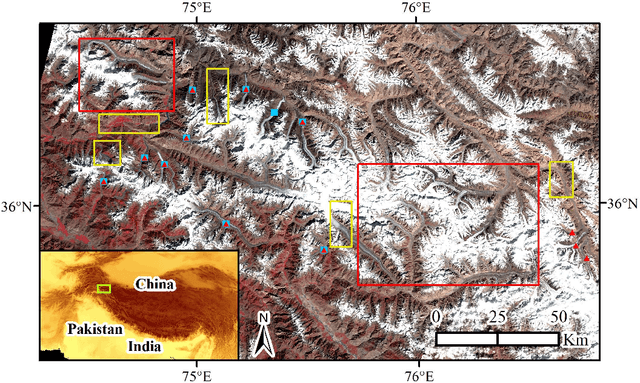
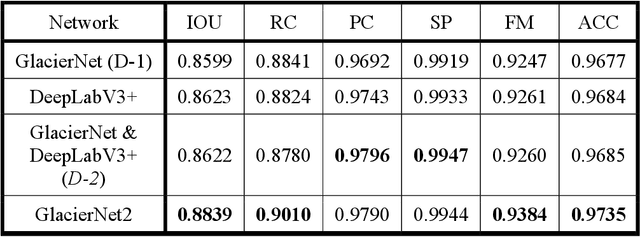
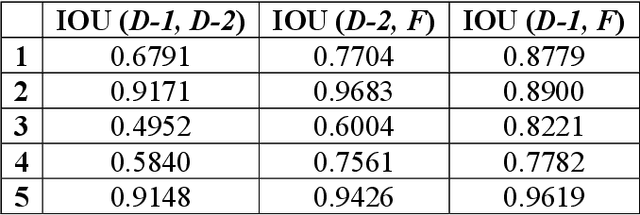
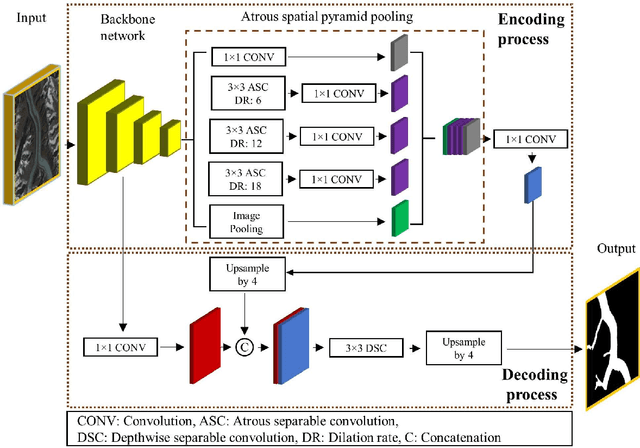
Abstract:In recent decades, climate change has significantly affected glacier dynamics, resulting in mass loss and an increased risk of glacier-related hazards including supraglacial and proglacial lake development, as well as catastrophic outburst flooding. Rapidly changing conditions dictate the need for continuous and detailed observations and analysis of climate-glacier dynamics. Thematic and quantitative information regarding glacier geometry is fundamental for understanding climate forcing and the sensitivity of glaciers to climate change, however, accurately mapping debris-cover glaciers (DCGs) is notoriously difficult based upon the use of spectral information and conventional machine-learning techniques. The objective of this research is to improve upon an earlier proposed deep-learning-based approach, GlacierNet, which was developed to exploit a convolutional neural-network segmentation model to accurately outline regional DCG ablation zones. Specifically, we developed an enhanced GlacierNet2 architecture thatincorporates multiple models, automatic post-processing, and basin-level hydrological flow techniques to improve the mapping of DCGs such that it includes both the ablation and accumulation zones. Experimental evaluations demonstrate that GlacierNet2 improves the estimation of the ablation zone and allows a high level of intersection over union (IOU: 0.8839) score. The proposed architecture provides complete glacier (both accumulation and ablation zone) outlines at regional scales, with an overall IOU score of 0.8619. This is a crucial first step in automating complete glacier mapping that can be used for accurate glacier modeling or mass-balance analysis.
R2U3D: Recurrent Residual 3D U-Net for Lung Segmentation
May 05, 2021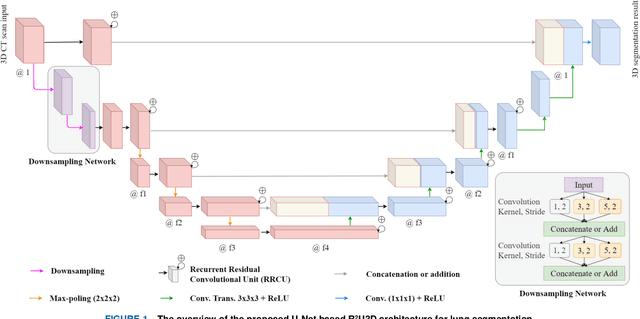

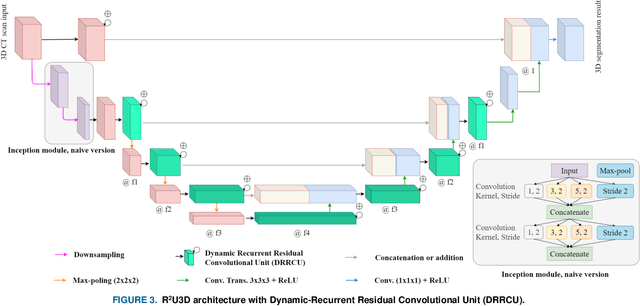

Abstract:3D lung segmentation is essential since it processes the volumetric information of the lungs, removes the unnecessary areas of the scan, and segments the actual area of the lungs in a 3D volume. Recently, the deep learning model, such as U-Net outperforms other network architectures for biomedical image segmentation. In this paper, we propose a novel model, namely, Recurrent Residual 3D U-Net (R2U3D), for the 3D lung segmentation task. In particular, the proposed model integrates 3D convolution into the Recurrent Residual Neural Network based on U-Net. It helps learn spatial dependencies in 3D and increases the propagation of 3D volumetric information. The proposed R2U3D network is trained on the publicly available dataset LUNA16 and it achieves state-of-the-art performance on both LUNA16 (testing set) and VESSEL12 dataset. In addition, we show that training the R2U3D model with a smaller number of CT scans, i.e., 100 scans, without applying data augmentation achieves an outstanding result in terms of Soft Dice Similarity Coefficient (Soft-DSC) of 0.9920.
Enhanced 3D Human Pose Estimation from Videos by using Attention-Based Neural Network with Dilated Convolutions
Mar 04, 2021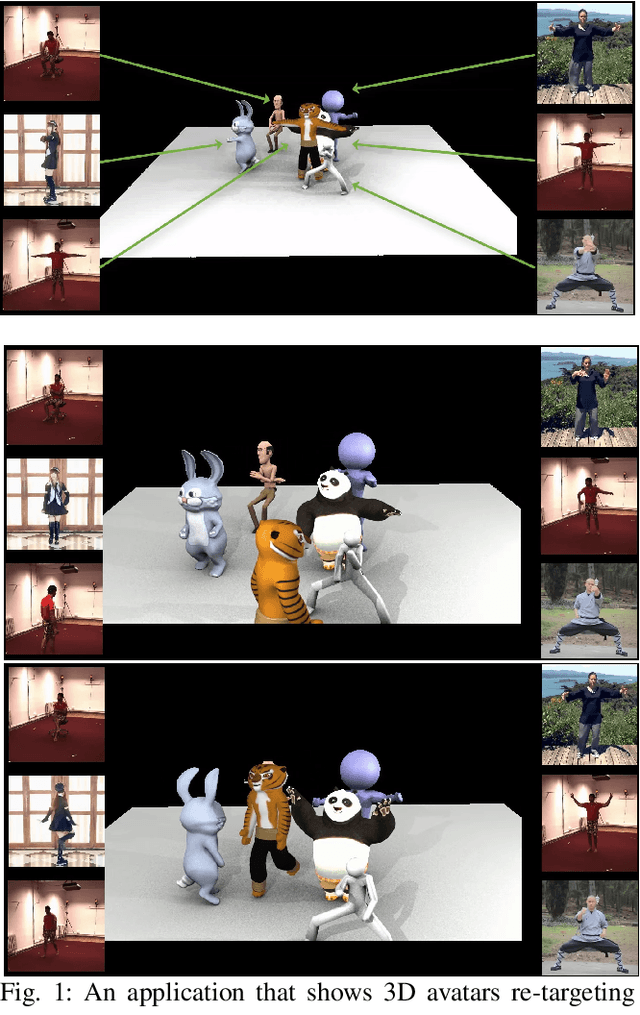
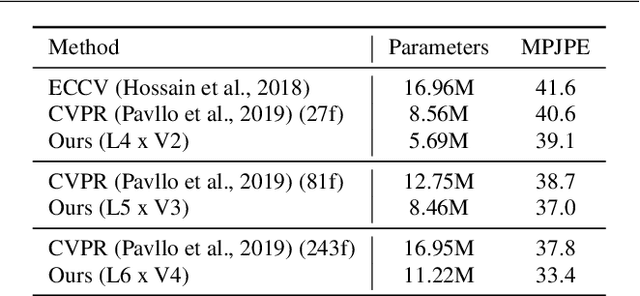
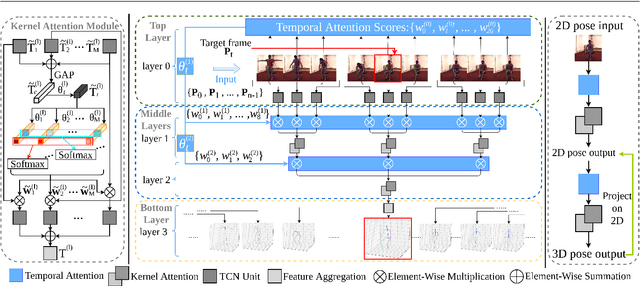
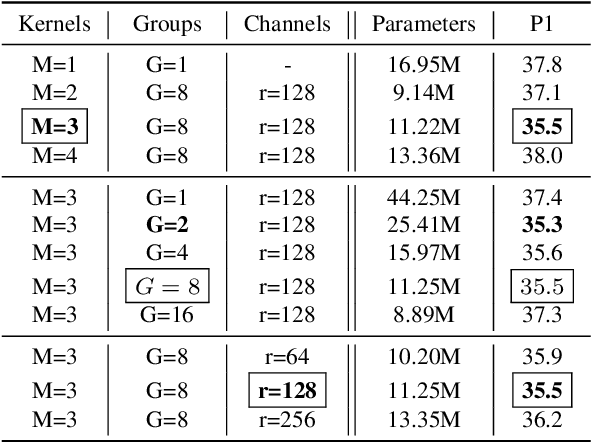
Abstract:The attention mechanism provides a sequential prediction framework for learning spatial models with enhanced implicit temporal consistency. In this work, we show a systematic design (from 2D to 3D) for how conventional networks and other forms of constraints can be incorporated into the attention framework for learning long-range dependencies for the task of pose estimation. The contribution of this paper is to provide a systematic approach for designing and training of attention-based models for the end-to-end pose estimation, with the flexibility and scalability of arbitrary video sequences as input. We achieve this by adapting temporal receptive field via a multi-scale structure of dilated convolutions. Besides, the proposed architecture can be easily adapted to a causal model enabling real-time performance. Any off-the-shelf 2D pose estimation systems, e.g. Mocap libraries, can be easily integrated in an ad-hoc fashion. Our method achieves the state-of-the-art performance and outperforms existing methods by reducing the mean per joint position error to 33.4 mm on Human3.6M dataset.
Pyramid Point: A Multi-Level Focusing Network for Revisiting Feature Layers
Nov 23, 2020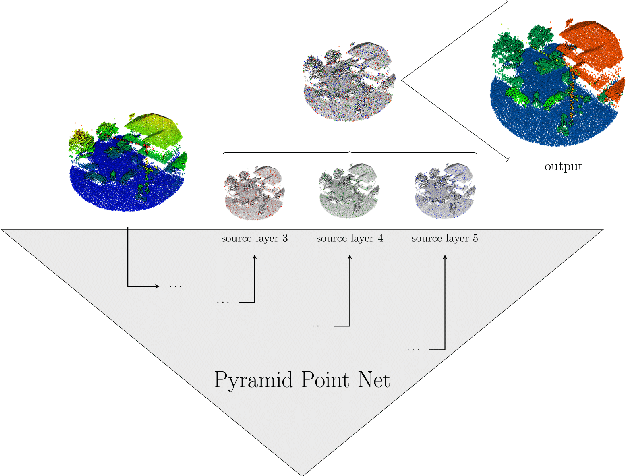

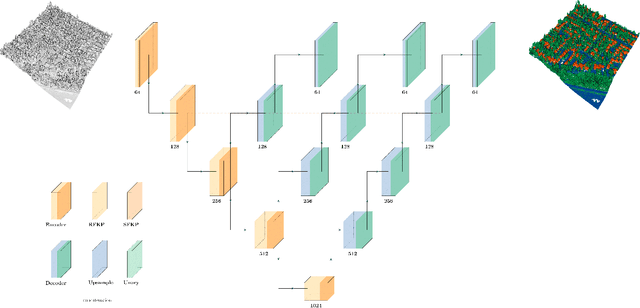

Abstract:We present a method to learn a diverse group of object categories from an unordered point set. We propose our Pyramid Point network, which uses a dense pyramid structure instead of the traditional 'U' shape, typically seen in semantic segmentation networks. This pyramid structure gives a second look, allowing the network to revisit different layers simultaneously, increasing the contextual information by creating additional layers with less noise. We introduce a Focused Kernel Point convolution (FKP Conv), which expands on the traditional point convolutions by adding an attention mechanism to the kernel outputs. This FKP Conv increases our feature quality and allows us to weigh the kernel outputs dynamically. These FKP Convs are the central part of our Recurrent FKP Bottleneck block, which makes up the backbone of our encoder. With this distinct network, we demonstrate competitive performance on three benchmark data sets. We also perform an ablation study to show the positive effects of each element in our FKP Conv.
GanglionNet: Objectively Assess the Density and Distribution of Ganglion Cells With NABLA-N Network
Jul 05, 2020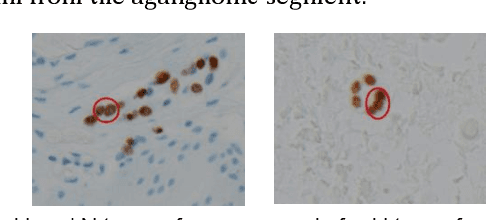

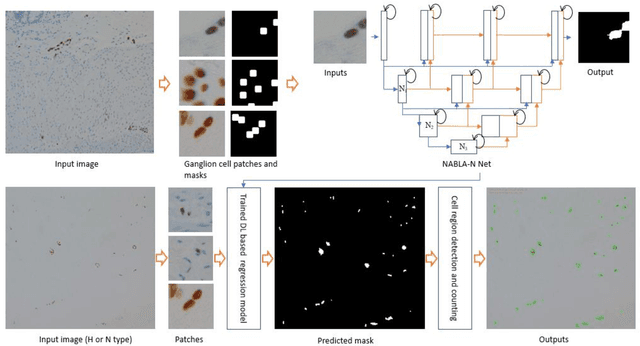
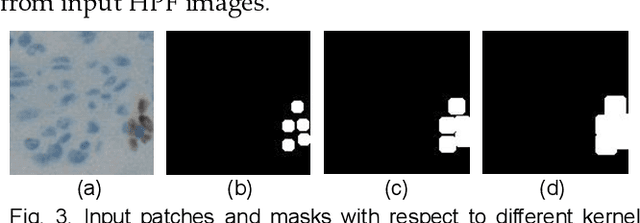
Abstract:Hirschsprungs disease (HD) is a birth defect which is diagnosed and managed by multiple medical specialties such as pediatric gastroenterology, surgery, radiology, and pathology. HD is characterized by absence of ganglion cells in the distal intestinal tract with a gradual normalization of ganglion cell numbers in adjacent upstream bowel, termed as the transition zone (TZ). Definitive surgical management to remove the abnormal bowel requires accurate assessment of ganglion cell density in histological sections from the TZ, which is difficult, time-consuming and prone to operator error. We present an automated method to detect and count immunostained ganglion cells using a new NABLA_N network based deep learning (DL) approach, called GanglionNet. The morphological image analysis methods are applied for refinement of the regions for counting of the cells and define ganglia regions (a set of ganglion cells) from the predicted masks. The proposed model is trained with single point annotated samples by the expert pathologist. The GanglionNet is tested on ten completely new High Power Field (HPF) images with dimension of 2560x1920 pixels and the outputs are compared against the manual counting results by the expert pathologist. The proposed method shows a robust 97.49% detection accuracy for ganglion cells, when compared to counts by the expert pathologist, which demonstrates the robustness of GanglionNet. The proposed DL based ganglion cell detection and counting method will simplify and standardize TZ diagnosis for HD patients.
COVID_MTNet: COVID-19 Detection with Multi-Task Deep Learning Approaches
Apr 18, 2020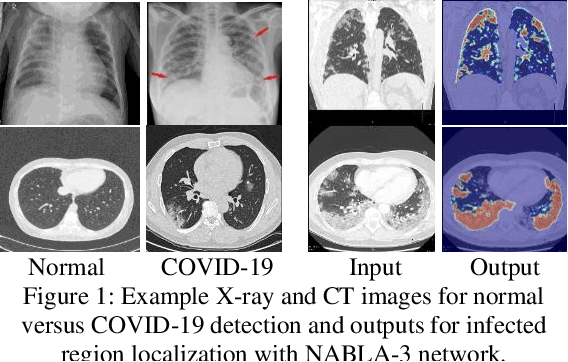
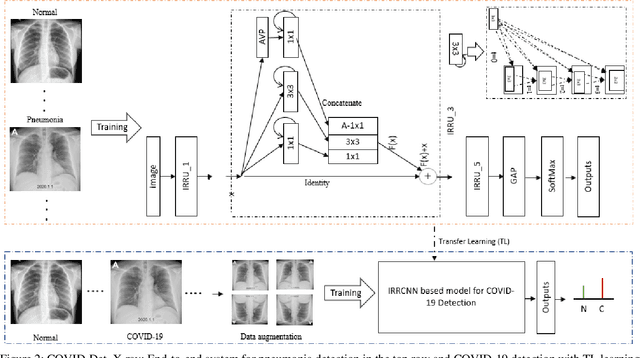
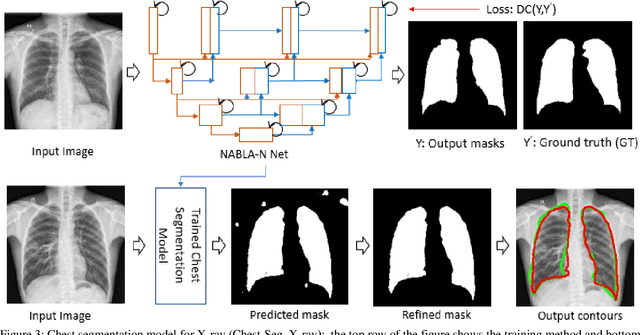
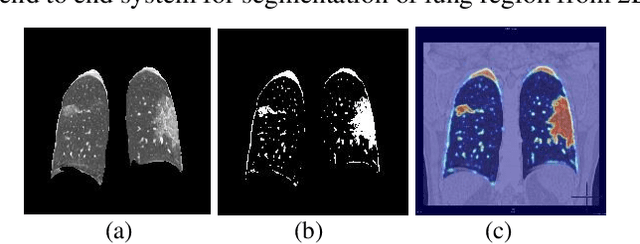
Abstract:COVID-19 is currently one the most life-threatening problems around the world. The fast and accurate detection of the COVID-19 infection is essential to identify, take better decisions and ensure treatment for the patients which will help save their lives. In this paper, we propose a fast and efficient way to identify COVID-19 patients with multi-task deep learning (DL) methods. Both X-ray and CT scan images are considered to evaluate the proposed technique. We employ our Inception Residual Recurrent Convolutional Neural Network with Transfer Learning (TL) approach for COVID-19 detection and our NABLA-N network model for segmenting the regions infected by COVID-19. The detection model shows around 84.67% testing accuracy from X-ray images and 98.78% accuracy in CT-images. A novel quantitative analysis strategy is also proposed in this paper to determine the percentage of infected regions in X-ray and CT images. The qualitative and quantitative results demonstrate promising results for COVID-19 detection and infected region localization.
DALES: A Large-scale Aerial LiDAR Data Set for Semantic Segmentation
Apr 14, 2020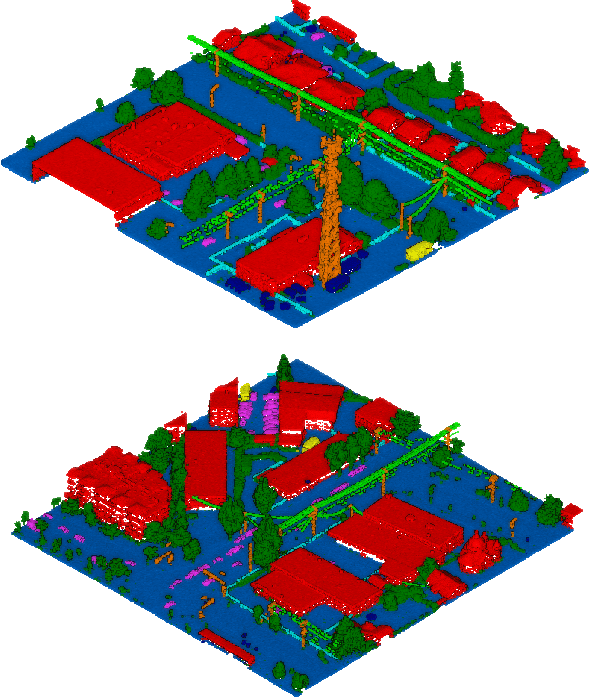

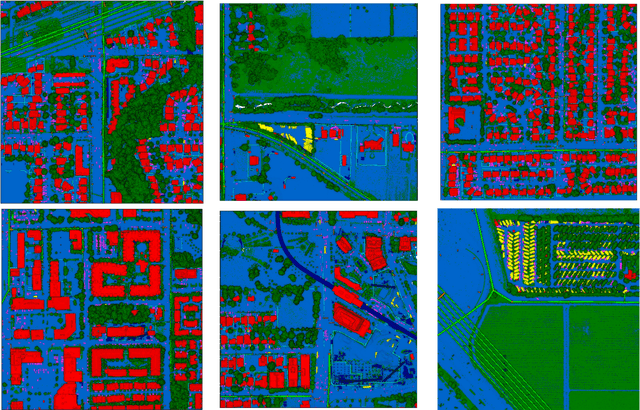

Abstract:We present the Dayton Annotated LiDAR Earth Scan (DALES) data set, a new large-scale aerial LiDAR data set with over a half-billion hand-labeled points spanning 10 square kilometers of area and eight object categories. Large annotated point cloud data sets have become the standard for evaluating deep learning methods. However, most of the existing data sets focus on data collected from a mobile or terrestrial scanner with few focusing on aerial data. Point cloud data collected from an Aerial Laser Scanner (ALS) presents a new set of challenges and applications in areas such as 3D urban modeling and large-scale surveillance. DALES is the most extensive publicly available ALS data set with over 400 times the number of points and six times the resolution of other currently available annotated aerial point cloud data sets. This data set gives a critical number of expert verified hand-labeled points for the evaluation of new 3D deep learning algorithms, helping to expand the focus of current algorithms to aerial data. We describe the nature of our data, annotation workflow, and provide a benchmark of current state-of-the-art algorithm performance on the DALES data set.
TGGLines: A Robust Topological Graph Guided Line Segment Detector for Low Quality Binary Images
Feb 27, 2020
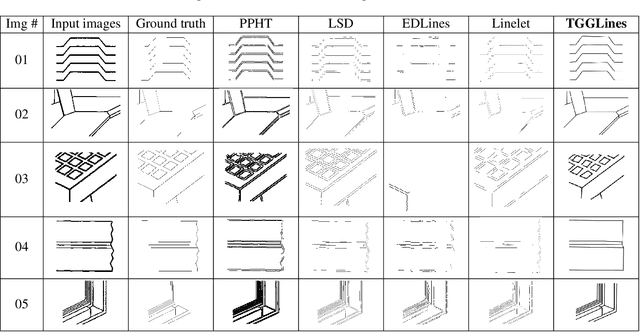
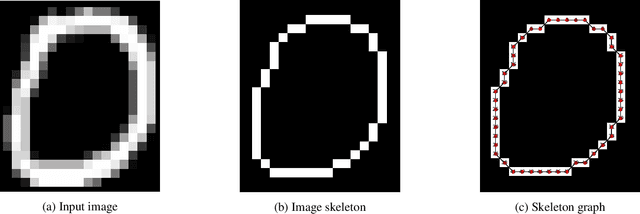
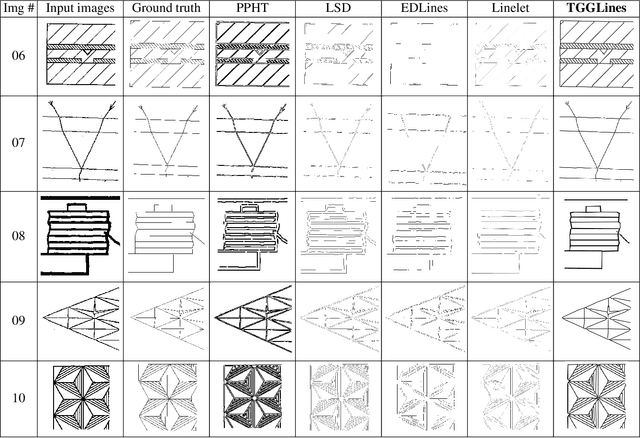
Abstract:Line segment detection is an essential task in computer vision and image analysis, as it is the critical foundation for advanced tasks such as shape modeling and road lane line detection for autonomous driving. We present a robust topological graph guided approach for line segment detection in low quality binary images (hence, we call it TGGLines). Due to the graph-guided approach, TGGLines not only detects line segments, but also organizes the segments with a line segment connectivity graph, which means the topological relationships (e.g., intersection, an isolated line segment) of the detected line segments are captured and stored; whereas other line detectors only retain a collection of loose line segments. Our empirical results show that the TGGLines detector visually and quantitatively outperforms state-of-the-art line segment detection methods. In addition, our TGGLines approach has the following two competitive advantages: (1) our method only requires one parameter and it is adaptive, whereas almost all other line segment detection methods require multiple (non-adaptive) parameters, and (2) the line segments detected by TGGLines are organized by a line segment connectivity graph.
Skin Cancer Segmentation and Classification with NABLA-N and Inception Recurrent Residual Convolutional Networks
Apr 25, 2019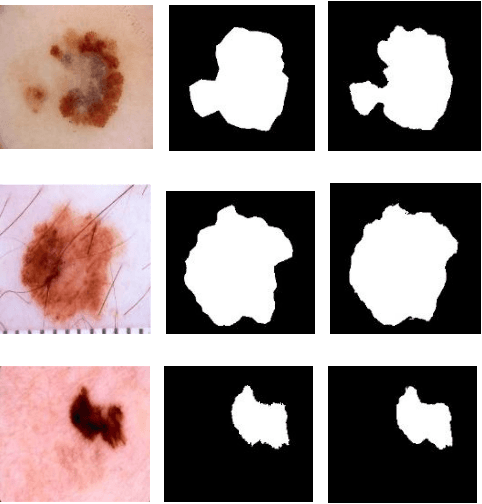

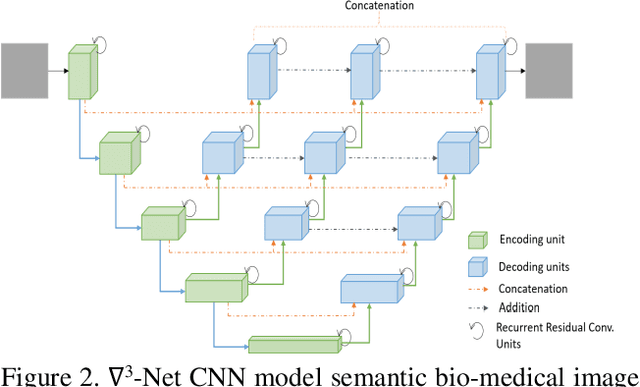
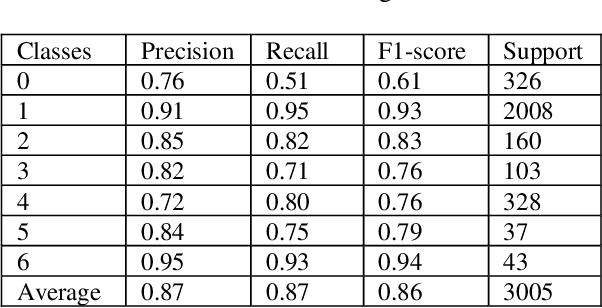
Abstract:In the last few years, Deep Learning (DL) has been showing superior performance in different modalities of biomedical image analysis. Several DL architectures have been proposed for classification, segmentation, and detection tasks in medical imaging and computational pathology. In this paper, we propose a new DL architecture, the NABLA-N network, with better feature fusion techniques in decoding units for dermoscopic image segmentation tasks. The NABLA-N network has several advances for segmentation tasks. First, this model ensures better feature representation for semantic segmentation with a combination of low to high-level feature maps. Second, this network shows better quantitative and qualitative results with the same or fewer network parameters compared to other methods. In addition, the Inception Recurrent Residual Convolutional Neural Network (IRRCNN) model is used for skin cancer classification. The proposed NABLA-N network and IRRCNN models are evaluated for skin cancer segmentation and classification on the benchmark datasets from the International Skin Imaging Collaboration 2018 (ISIC-2018). The experimental results show superior performance on segmentation tasks compared to the Recurrent Residual U-Net (R2U-Net). The classification model shows around 87% testing accuracy for dermoscopic skin cancer classification on ISIC2018 dataset.
Advanced Deep Convolutional Neural Network Approaches for Digital Pathology Image Analysis: a comprehensive evaluation with different use cases
Apr 19, 2019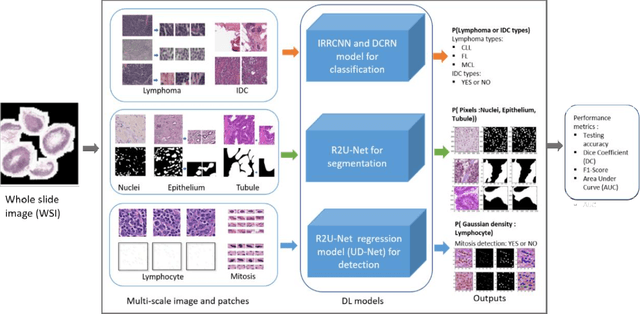



Abstract:Deep Learning (DL) approaches have been providing state-of-the-art performance in different modalities in the field of medical imagining including Digital Pathology Image Analysis (DPIA). Out of many different DL approaches, Deep Convolutional Neural Network (DCNN) technique provides superior performance for classification, segmentation, and detection tasks. Most of the task in DPIA problems are somehow possible to solve with classification, segmentation, and detection approaches. In addition, sometimes pre and post-processing methods are applied for solving some specific type of problems. Recently, different DCNN models including Inception residual recurrent CNN (IRRCNN), Densely Connected Recurrent Convolution Network (DCRCN), Recurrent Residual U-Net (R2U-Net), and R2U-Net based regression model (UD-Net) have proposed and provide state-of-the-art performance for different computer vision and medical image analysis tasks. However, these advanced DCNN models have not been explored for solving different problems related to DPIA. In this study, we have applied these DCNN techniques for solving different DPIA problems and evaluated on different publicly available benchmark datasets for seven different tasks in digital pathology including lymphoma classification, Invasive Ductal Carcinoma (IDC) detection, nuclei segmentation, epithelium segmentation, tubule segmentation, lymphocyte detection, and mitosis detection. The experimental results are evaluated with different performance metrics such as sensitivity, specificity, accuracy, F1-score, Receiver Operating Characteristics (ROC) curve, dice coefficient (DC), and Means Squired Errors (MSE). The results demonstrate superior performance for classification, segmentation, and detection tasks compared to existing machine learning and DCNN based approaches.
 Add to Chrome
Add to Chrome Add to Firefox
Add to Firefox Add to Edge
Add to Edge